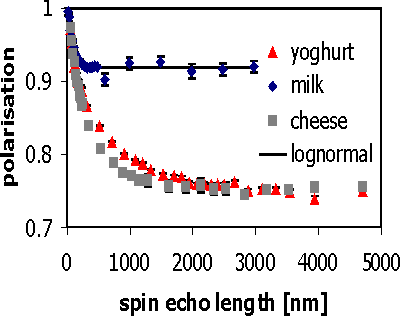Yoghurt formation studied with SESANS
The main components of milk are caseine micelles that are polydisperse protein particles of up to several hundred nm in size. This can be seen in the SESANS measurement on a suspension of fat-free milk powder in D2O, where the signal saturates after a spin-echo length of 300 nm. Yoghurt is made by acidifying the milk. We acidified deuterated milk and repeated the measurement after one day of equilibration. The signal of the yoghurt continues to decrease up to a spin-echo length of 3 mm, which means that the micelles have aggregated to much larger structures. We then modelled the process of cheese making by adding an enzyme to start the aggregation of the micelles. This created another structure. The decay at the short length-scales is much faster, which means that a more open structure has been formed than with the yoghurt. This quantitative information on the bulk of yoghurt and cheese is unique and cannot be obtained by any other method.

A novel application of neutron scattering on dairy products, R.H. Tromp and, W.G. Bouwman, Food Hydrocolloids 21, 154-158 (2007), http://dx.doi.org/10.1016/j.foodhyd.2006.02.008